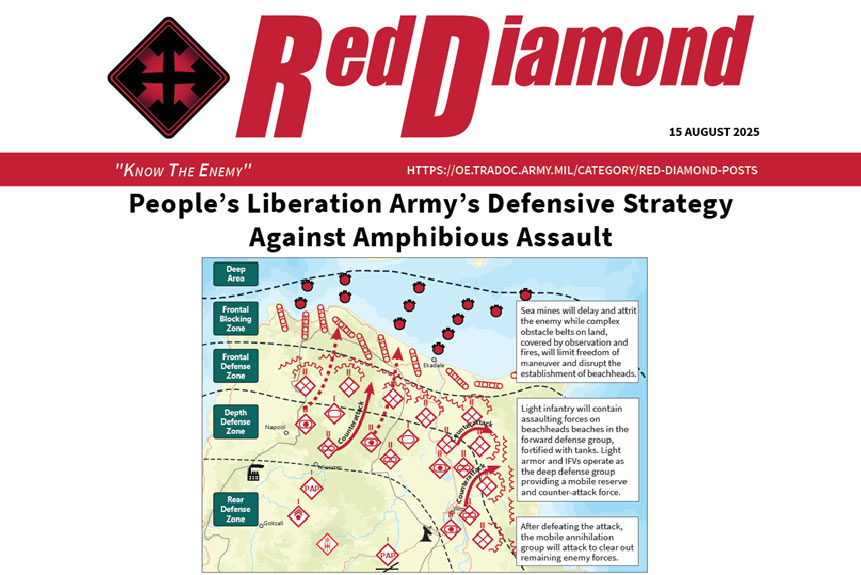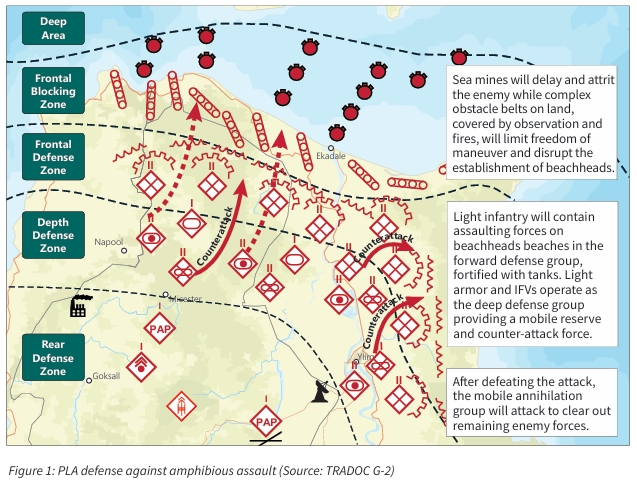
People’s Liberation Army’s Defensive Strategy Against Amphibious Assault
By John Tierney
China’s People’s Liberation Army (PLA) focuses on deterrence and counterattacks in defending
against amphibious assaults, emphasizing that a well-coordinated active defense, while strategically
disadvantageous, provides operational advantages in terrain and time. China’s military strategy is rooted
in active defense, combining a strategically defensive posture with offensive operational and tactical
capabilities.1 Active defense involves early engagement with the enemy and a focus on counterattack.
The PLA prioritizes deterrence and antiaccess/area denial (A2/AD) capabilities over developing specific
defenses against amphibious assaults. The PLA views a well-coordinated defense, should deterrence fail,
as essential in combat, because it weakens enemy forces, secures key terrain, and creates opportunities
for successful offensive operations.2
The PLA considers the defensive position of an amphibious assault as a strategic disadvantage,
even if it offers some tactical advantages.3 In its assessment, the inability to deter an amphibious assault
results from cascading failures in other operational domains, demonstrating that efforts to counter enemy
intervention were unsuccessful. However, the PLA sees the positional defense not as an end state but
as an opportunity: by absorbing the initial momentum of an amphibious assault, it aims to weaken the
enemy and set the conditions to transition back to offensive operations.
China’s defense strategy intends to deter any foreign intervention before the threat reaches
their shores by using information, economic, counterspace, and cyber actions. China’s information
operations (IO) would likely focus on establishing the political legitimacy of PLA territorial claims and
framing intervention as a violation of China’s sovereignty. The Chinese Communist Party’s IO campaign
directed at regional actors would be to discourage outside intervention, while messaging to the broader
international community would seek to justify China’s escalation.
The PLA perceives an amphibious assault as a high-risk endeavor for the adversary and aims to make
the operation prohibitively costly by employing a comprehensive A2/AD denial strategy that integrates
naval, air, and missile forces. The PLA heavily invests in developing robust A2/AD capabilities, including
naval, air, and land-based missile systems. The PLA will attempt to disrupt, delay, and even annihilate
the enemy as far forward as possible. PLA Navy, Air Force, and Rocket Force assets will participate in a
theater-wide A2/AD campaign. These assets aim to deny adversarial forces access to China’s territorial
waters and airspace, creating a formidable barrier against amphibious operations.
Maritime and Coastal Defense. Chinese military writings emphasize a strong maritime posture
supported by coastal defense missile batteries.4
» The PLA Navy is crucial in coastal defense and would deter adversaries through naval, air,
and land-to-sea missile capabilities if confronted with a seaborne threat.
» The PLA Navy would likely assume a maneuver defense at sea, aiming to deter foreign
intervention by posing a credible threat to enemy naval forces.
» China’s surface ships maintain a robust antiaircraft capability, and they are likely employed
in concert with ground-based air defenses to deny use of wide geographic areas to enemy
aircraft.
» Coastal defense shore-based antiship missile batteries will conduct firepower assaults at
maximum range to deter amphibious approaches.
» The maritime militia, in the form of nationalized commercial vessels, will contribute to
delaying mobilization activity by congesting sea lanes and performing surveillance and
reconnaissance.
• Air Defense. The PLA Air Force will conduct an air dominance campaign to deny air superiority
through aggressive targeting of enemy aircraft and air defense assets.
» PLA doctrine does not advocate air-to-air engagements beyond the demonstration of the
national will to contest the air domain.
» Layered employment of decoy aircraft and electronic attack assets will identify and suppress
air defense radars to set conditions for air firepower assaults against air defense networks.
» The PLA Air Force’s goal is to decisively engage adversarial air capabilities while they are
still on the ground.5
• Rocket Forces. PLA Rocket Forces are positioned as strategic deterrence forces. Limited and
direct missile firepower assaults targeting adversarial airfield and carrier groups will serve as a
final deterrence against escalating hostilities.6
The PLA would likely avoid a resource-intensive static defense of vulnerable beachheads and instead
focus on weakening enemy forces and creating opportunities for counterattacks. The focus of the PLA’s
defense would be on setting conditions for an effective counterattack by forcing the enemy’s assault force
to defend on disadvantaged terrain at the landing site.7 Direct engagement with the amphibious assault
forces would be carried out by PLA combined arms brigades (CAB) using a positional defense to fix and
attrit the landing force. The tactic relies on layered defenses, leveraging terrain advantages, and employing
joint fires to inflict maximum casualties, isolating the assault force and desynchronizing the offensive.
PLA CABs would prioritize survivability by minimizing their presence on the beachhead and instead
positioning their defenses in the frontal defense zone to disrupt forward elements and anchor layered
defenses.8 This technique would relieve the defenders from occupying the disadvantaged terrain and
allow littoral waters to separate elements of the assaulting force at echelon.9 The defending force will
use stand-off capabilities and coordinate joint fires to attack assault forces while loading, moving, and
assembling. For a division-level defense, each CAB’s principal positional defense would employ two
maneuver battalions forward in the frontal defense zone, in terrain beyond the beachhead. PLA Army
engineer assets would position obstacles and mines to delay, degrade, shape avenues of approach, and
establish kill zones. Engineers would also build fighting positions to support the main defense in the battle zone, capitalizing on existing infrastructure for cover and concealment. Prior to contact with the enemy’s assault forces, the PLA would focus fires on high-payoff targets such as ammunition stockpiles,
assembly areas, fuel stockpiles, and fire support assets. Organic air defense assets will be positioned for
antiair ambushes in the depth defense zone.

The primary objective in the early phase of the defense is to preserve combat power while denying
the enemy an inland foothold. The PLA would aim to transition decisively to counteroffensive operations
by degrading enemy capabilities and morale through targeted strikes, isolating landing forces, and
securing rear areas.
• Initial Defense. The PLA Army would conduct limited, precision attacks within the battle zone to
weaken the enemy forces, disrupt their assault tempo, and erode morale. Brigade fire support and
aviation assets will target the enemy’s efforts to build combat power in the forward security zone.
• Isolation of Landing Forces. To isolate the landing force, the PLA would employ continuous
strikes to fragment the amphibious units, prevent reinforcement, and deny expansion beyond
the beachhead.
• Rear-Area Security. The People’s Armed Police would secure the rear defensive zone to guard
against encirclement attempts, airborne insertions, and other threats to the rear area.
• Transition to Offense. Once the assault has been blunted, the PLA would transition to the offense
to exploit enemy disarray and regain the initiative.
The counterattack is the decisive phase of a PLA defense, with rapid restoration of naval support
serving as the critical trigger for transitioning to offensive operations. Achieving naval and air superiority
to disrupt support and resupply for the assaulting force is essential for launching a successful counterattack
against the amphibious landing force.
If the PLA cannot quickly regain naval advantage, the defenders would shift to targeted raids
against enemy logistics, support, fire support, and command-and-control assets to keep the assault
force fixed at the landing site. Meanwhile, higher-echelon PLA units would likely bypass and isolate the
invading force. By successfully repelling an amphibious assault, the PLA aims to demonstrate its resilience,
undermine enemy morale and potentially reshape the political landscape of the conflict.
A thorough assessment of the PLA’s defensive strategy against amphibious assaults reveals several
vulnerabilities. These vulnerabilities highlight that, despite significant modernization and growing
capabilities, the PLA’s defensive strategy is not without significant risks—particularly if adversaries can
exploit gaps in technology, joint integration, or naval strength.
• Reliance on A2/AD Capabilities: The effectiveness of the PLA’s A2/AD capabilities depends on
several factors, including technological superiority, intelligence gathering, and operational security.
If these assets are degraded or neutralized, it could significantly weaken China’s ability to repel
intervention.
• Joint Operations and Coordination: Deficiencies in joint operations, where the PLA has limited
experience, could impede the PLA’s ability to effectively counter a well-coordinated amphibious
assault, which represents a convergence of multiple operational domains and a shift in focus from
naval engagements to ground warfare.
• Naval Limitations: While China possesses the world’s largest navy by ship count, it has fewer
major surface combatant ships, and less experience compared to the U.S. Navy. If the PLA Navy
fails to slow the attacking force, the PLA Army would be faced with a stronger enemy assault.
IMPLICATIONS FOR LARGE-SCALE COMBAT OPERATIONS
The PLA’s comprehensive strategy for defending contested terrain against amphibious assaults
presents U.S. forces with a highly complex, multidomain challenge that demands robust countermeasures
and adaptive training.
• All-Domain Defense. The PLA coordinates air, maritime, and land assets to create layered defenses,
employing A2/AD tactics and threatening intervening forces with long-range missiles and electronic
warfare. This layered defense approach presents intervening forces with all-domain dilemmas,
which require substantial firepower, logistical support, and close coordination across all military
branches.
• Battlefield Transparency and Deception. Continuous PLA surveillance enables early detection
and targeting of enemy forces, shaping the battlefield before an amphibious assault commences.
To counter this, concealment, deception, and emission control are critical to achieving strategic
surprise on a transparent battlefield.
• A2/AD and Electronic Threats. The PLA’s A2/AD capabilities—including advanced missile systems,
air and naval power, and electronic warfare—pose significant threats to an intervening enemy’s
ships, aircraft, and communication networks. Therefore, a focus on developing and rehearsing
counter-A2/AD strategies, robust protection, and the ability to operate under sustained enemy
contact are critical to persevering in this type of conflict.
• Space and Cyber Disruption. The PLA’s emphasis on space and cyber disruption would likely
impact positioning, navigation, and timing; communications; and ISR capabilities. Such disruptions
hinder the effective coordination and execution of amphibious operations. To mitigate these risks,
consider potential capabilities such as resilient communication systems, training in traditional
navigation methods, and robust cyber defenses.
• Contested Logistics. The PLA’s doctrine suggests preemptive actions during the mobilization and
transit stages, highlighting the challenges of contested logistics. To counter this, the U.S. Army
could benefit from examining enhanced protection efforts throughout the depths of the battlefield,
on lines of communication, and extending back to home station.
END NOTES
- Office of the Secretary of Defense. “Military and Security Developments Involving the People’s Republic of China 2023.”
Annual Report to Congress, October 19, 2023. https://media.defense.gov/2023/Oct/19/2003323409/-1/-1/1/2023-MILITARY
AND-SECURITY-DEVELOPMENTS-INVOLVING-THE-PEOPLES-REPUBLIC-OF-CHINA.PDF - Department of the Army. 2021. Chinese Tactics. Department of the Army. https://armypubs.army.mil/ProductMaps/PubForm/
Details.aspx?PUB_ID=1023379. - China Aerospace Studies Institute. 2024. In Their Own Words: On Maritime Strategic Access. China Aerospace Studies Institute.
https://www.airuniversity.af.edu/CASI/Display/Article/3674462/in-their-own-words-on-maritime-strategic-access/. (146) - China Aerospace Studies Institute. 2024. In Their Own Words: On Maritime Strategic Access. China Aerospace Studies Institute.
https://www.airuniversity.af.edu/CASI/Display/Article/3674462/in-their-own-words-on-maritime-strategic-access/. (66,67) - China Aerospace Studies Institute. 2010. In their Own Words: PLA’s Services and Arms Applications in Joint Operations. China
Aerospace Studies Institute. https://www.airuniversity.af.edu/CASI/Display/Article/2827007/in-their-own-words-services
and-arms-application-in-joint-operations/ (189) - China Aerospace Studies Institute. 2010. In their Own Words: PLA’s Services and Arms Applications in Joint Operations. China
Aerospace Studies Institute. https://www.airuniversity.af.edu/CASI/Display/Article/2827007/in-their-own-words-services
and-arms-application-in-joint-operations/ (189) - China Aerospace Studies Institute. 2020. In their Own Words: PLA’s Science of Campaigns. China Aerospace Studies Institute.
https://www.airuniversity.af.edu/CASI/Display/Article/2421219/in-their-own-words-plas-science-of-campaigns/ (230) - Department of the Army. 2021. Chinese Tactics. Department of the Army. https://armypubs.army.mil/ProductMaps/PubForm/
Details.aspx?PUB_ID=1023379. (8-47) - Department of the Army. 2021. Chinese Tactics. Department of the Army. https://armypubs.army.mil/ProductMaps/PubForm/
Details.aspx?PUB_ID=1023379. (8-57)
Distribution A: Approved for public release
Categories:
Tags:
People’s Liberation Army’s Defensive Strategy Against Amphibious Assault
By John Tierney
File Size:
453KB
File Type:
Page Count:
6

